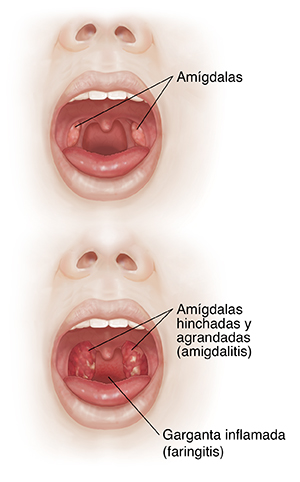Tonsillitis is an inflammation or infection of your child's tonsils. Your child has two tonsils, one on either side of their throat. The tonsils are pink, oval-shaped glands. They help prevent infections. But tonsils can become infected themselves. Tonsillitis is a common childhood condition.
Tonsillitis can be caused by bacteria or a virus. The main symptom is a sore throat. Your child may also have a fever and red and swollen tonsils. Swallowing can be painful or uncomfortable. The tonsils may also look white, gray, or yellow because of a coating on them. Your child may have swollen lymph nodes or glands in their neck.
Your child may have a rapid strep test or a throat culture. The rapid strep test gives results right away. Sometimes both tests are done. These tests will find out if your child has a bacterial or a viral infection. If your child has a bacterial infection, they may need to take antibiotics. An antibiotic is used to treat a bacterial infection. Antibiotics don’t work against viral infections. Your child may need surgery to remove the tonsils if they cause breathing problems. Or they may need surgery if they have several infections in 1 year.
Home care
If your child’s doctor has prescribed antibiotics or another medicine, give it to your child as directed. Be sure your child finishes all of the medicine, even if they feel better.
To help ease your child’s sore throat:
-
Your child can take over-the-counter pain medicines, such as acetaminophen or ibuprofen. Do not use ibuprofen if your child is less than 6 months old unless the doctor gave you instructions to use it. Be safe with medicines. Read and follow all instructions on the label. Do not give aspirin to anyone younger than 20. It has been linked to Reye syndrome, a serious illness.
-
Offer cool liquids to drink.
-
Have your child gargle with warm salt water several times a day to help reduce swelling and relieve pain. Mix 1/2 teaspoon of salt in 1 cup of warm water. Most children can gargle when they are 6 years old.
The germs that cause tonsillitis are very contagious. To help prevent their spread, follow these tips:
-
Teach your child to wash their hands often.
-
Don’t let your child share cups or utensils with other people.
-
Keep your child away from other children until they are better. Talk with your child's doctor about when your child can return to school or daycare.
Follow-up care
Follow up with your child's doctor as advised.
When to get medical advice
Unless advised otherwise, contact your child's doctor if your child:
-
Has a sore throat with fever, headache, stomachache, or rash.
-
Has neck pain or stiff neck with a fever that is new or getting worse.
-
Refuses to eat or has problems eating.
-
Acts strange or different.
-
Has symptoms that are new or getting worse, like pain on one side of their throat.
-
Has trouble opening their mouth, a muffled voice, or drooling.
Call 911
Call
-
Has trouble breathing or has lost consciousness.
Author: Semko, Laura
© 2000-2025 The StayWell Company, LLC. All rights reserved. This information is not intended as a substitute for professional medical care. Always follow your healthcare professional's instructions.


